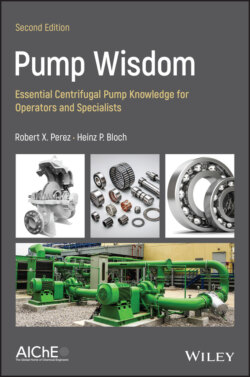Читать книгу Pump Wisdom - Robert X. Perez - Страница 27
Epoxy Prefilled Baseplates
ОглавлениеAs of about 2000, Best Practices Companies (BPCs) have increasingly used “monolithic” (all‐in‐one, epoxy prefilled) steel baseplates in sizes approaching 1.5 m × 2.5 m (about 5 ft × 8 ft). Larger sizes become cumbersome due to heavy weight.
In the size range up to about 1.5 m × 2.5 m, conventional grouting procedures, although briefly mentioned in this text, are being phased out in favor of baseplates prefilled with an epoxy resin or grout [3]. These standard material prefilled steel baseplates then represent a solid block (the “monolith”) that will never twist and never get out‐of‐alignment.
The process includes five successive stages, all done under controlled conditions before shipment to the site:
1 Baseplate fabrication. (No pour holes are needed for prefilled baseplates)
2 Stress relieving
3 Pregrouting (primer application) in preparation for prefilling. (If there are large pour holes, the inverted baseplate must be placed on a sheet of plywood, Figure 3.7)
4 Fill with epoxy grout and allow it to bond and cure
5 Invert and machine the mounting pads to be flat; then verify flatness before shipment (Figure 3.8). Protect and ship (Figure 3.9) – possibly even with pump, coupling, and driver‐mounted and final‐aligned.
The advantage of prefilling is notable. Jobs with pumps in the 750 kW (1000 hp) category and total assemblies weighing over 12 000 kg (26,400 lbs) have been done without difficulty on many occasions. A conventionally grouted baseplate requires at least two pours, plus locating and repair‐filling of voids after the grout has cured. Prefilled or pregrouted baseplates travel better and arrive at the site flat and aligned, just as they left the factory. Their structural integrity is better because they do not require grout holes. Their installed cost is less and their long‐term reliability is greatly improved.
Figure 3.7 Underside of a baseplate after a prime coat has been applied. It is ready to be filled with epoxy. The large pour holes identify it as an old‐style “conventional” baseplate being converted to prefilled style.
Source: Stay‐Tru®, Houston, TX.
Figure 3.8 Flatness and level measurements determine if the now‐machined‐prefilled baseplate has been properly machined. It is then ready to be installed on a foundation at site.
Source: Stay‐Tru®, Houston, Texas.
Figure 3.9 Epoxy prefilled baseplate fully manufactured by a specialty company, shown ready for shipment.
Source: Stay‐Tru® Company, Houston, TX.
